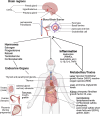Regulation of the blood-brain barrier function by peripheral cues in health and disease
- PMID: 39671124
- PMCID: PMC11645320
- DOI: 10.1007/s11011-024-01468-8
Regulation of the blood-brain barrier function by peripheral cues in health and disease
Abstract
The blood-brain barrier (BBB) is formed by microvascular endothelial cells which are ensembled with pericytes, astrocytes, microglia and neurons in the neurovascular unit (NVU) that is crucial for neuronal function. Given that the NVU and the BBB are highly dynamic and regulated structures, their integrity is continuously challenged by intrinsic and extrinsic factors. Herein, factors from peripheral organs such as gonadal and adrenal hormones may influence vascular function also in CNS endothelial cells in a sex- and age-dependent manner. The communication between the periphery and the CNS likely takes place in specific areas of the brain among which the circumventricular organs have a central position due to their neurosensory or neurosecretory function, owing to physiologically leaky blood vessels. In acute and chronic pathological conditions like liver, kidney, pulmonary disease, toxins and metabolites are generated that reach the brain via the circulation and may directly or indirectly affect BBB functionality via the activation of the immunes system. For example, chronic kidney disease (CKD) currently affects more than 840 million people worldwide and is likely to increase along with western world comorbidities of the cardio-vascular system in continuously ageing societies. Toxins leading to the uremic syndrome, may further lead to neurological complications such as cognitive impairment and uremic encephalopathy. Here we summarize the effects of hormones, toxins and inflammatory reactions on the brain vasculature, highlighting the urgent demand for mechanistically exploring the communication between the periphery and the CNS, focusing on the BBB as a last line of defense for brain protection.
Keywords: Alzheimer’s Disease; Blood-brain barrier; Chronic kidney disease; Hormones; Sex-specific function.
© 2024. The Author(s).
Conflict of interest statement
Declarations. Competing interests: The authors declare no competing interests.
Figures


References
-
- Abbott NJ, Patabendige AAK, Dolman DEM et al (2010) Structure and function of the blood-brain barrier. Neurobiol Dis 37:13–25. 10.1016/j.nbd.2009.07.030 - PubMed
-
- Ahmad AA, Gassmann M, Ogunshola OO (2012) Involvement of oxidative stress in hypoxia-induced blood–brain barrier breakdown. Microvasc Res 84:222–225. 10.1016/j.mvr.2012.05.008 - PubMed
Publication types
MeSH terms
LinkOut - more resources
Full Text Sources

